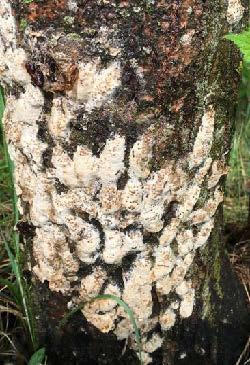Detect and treat for spongy moth in 2023
The Delaware Forest Service encourages landowners and other Delaware residents to scout for any spongy moth (formerly known as gypsy moth) egg masses this coming spring.
“Homeowners and woodland owners, especially in last year’s outbreak areas around the Cypress Swamp and Nanticoke State Wildlife areas, should be aware of what spongy moth (formerly ‘gypsy’ moth) egg masses look like, and roughly how many are in their neighborhood,” said Bill Seybold, Delaware forest health specialist. “They are most likely to be found on the trunks and undersides of main branches of both hardwood and pine trees, though they feed on the leaves of oaks and some other hardwood trees a bit later in May and June. The female moths laid egg masses in July and August. The insect has survived the winter in this egg-mass stage. Small, dark caterpillars about 0.25” will emerge from these egg masses, most likely in mid-April when temperatures have warmed enough. They are challenging to spot casually at this early stage; however, wary landowners can probably find them if they know and monitor nearby egg masses' conditions as the weather warms up.”
If spongy moth caterpillars or defoliation have been spotted during the growing season the previous June through August, residents should consider going out on a dry day between now and late April to look for egg masses on trunks. Any egg masses found should be scraped into soapy water. Fresh egg masses are yellow-brown, intact and firm to the touch. For more information on how to predict how much defoliation to expect next May and June, go to agriculture.delaware.gov/forest-service/forest-health.
According to Seybold, once caterpillars have emerged from the egg masses, besides contacting a licensed pesticide applicator, some do-it-yourself strategies can be used to lessen the leaf defoliation that individual trees suffer. The primary strategies are sticky barrier bands around trees for the earlier, smaller stages of caterpillars, and burlap or cloth collection bands around tree trunks in later May to early June when the caterpillars are much larger. These methods are not practical for anything more than a few trees, and they require a lot of maintenance. Contact the Delaware Forest Service for details.
The most common option for deciduous forests of about 20 acres or larger is to aerially spray the young larvae, usually in May, when the oak trees’ leaves measure at least an inch, and larvae are in the first and second stages of growth.
If a block of forest is under threat from heavy spongy moth defoliation, the property owner may choose a licensed applicator to do an aerial application. However, healthy caterpillars from unsprayed adjacent woodlands will drift into smaller areas and cause almost the same amount of damage as if not sprayed.
Forest landowners who suspect they may have enough egg masses per acre to warrant a privately contracted spray may call the forest health specialist at 302-698-4553 for technical assistance and a list of aerial applicators. Currently, the Delaware Department of Agriculture does not have an organized spray program with financial assistance.
For information about other control methods, the Delaware Forest Service strongly recommends using a website created by a university extension system, or a federal or state government entity.




















































